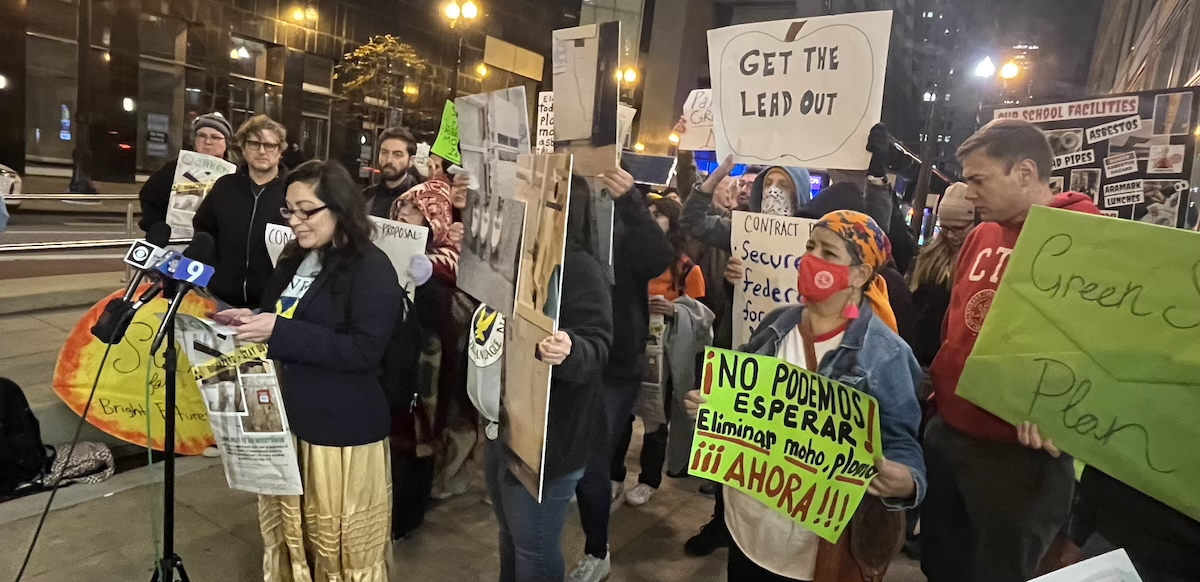Chicago Teachers Win Greener Schools

In November, Chicago teachers and parents rallied to demand healthy green schools provisions in the Chicago Teacher Union contract. The contract was ratified in April. Photo: CTU
The Chicago Teachers Union won a tentative agreement in December that, for the first time, addresses climate and environmental justice demands—making healthy green schools a priority in our city. We achieved this breakthrough even while broader contract negotiations stalled. Finally, in April, we ratified the full agreement, which also includes big raises and lower class sizes.
Our environmental justice victory stems from a collaboration between teachers and environmental activists to expose urgent problems facing us and our students—and link those problems to larger struggles.
Chicago’s public school buildings have an average age of 82 years. Many are in underfunded and polluted majority Black and Latino neighborhoods. They are in serious need of repairs and modernization. Lead paint, asbestos, and mold are widespread; unreliable heating and cooling systems make learning difficult. School buildings are also pumping fossil fuel emissions into already polluted communities.
So our union joined forces with local environmental justice and community groups in a citywide campaign for healthy green schools. We have demanded to remove toxins like asbestos; reduce our climate pollution, including by installing solar panels; prepare students for green jobs; provide high-quality school lunches; and ensure funds for the schools in the majority Black and Brown communities most harmed by pollution.
Our new contract language will create pathways to green jobs for high school students, increase resources to teach about climate issues, and open the door to toxin removal, green building upgrades, and better school lunches.
Importantly, the contract will also establish a joint labor-management Green Schools and Climate Preparedness Committee. It forces the district to work with the union to secure funding to:
- Cut lead in drinking water and install up to 200 filtered-water drinking fountains
- Expand monitoring of indoor air quality
- Increase cooking-from-scratch capability in school cafeterias and expand lunchroom composting in 25 schools
- Replace windows and upgrade HVAC equipment (e.g. heat pumps)
- Advance building electrification and install solar panels at 30 schools
- Construct new school facilities to meet LEED Silver-certified standards or higher
- Collaborate with unions such as the Electrical Workers (IBEW) to create more pre-apprenticeship opportunities for students
Our union has built a powerful culture of bargaining for the common good, making demands like wrap-around services and housing for our students. This made our green schools campaign possible.
Still, it took rank-and-file initiative to build the campaign. Here are some of the strategies that worked for us:
ENGAGING MEMBERS
We showed our union leaders that members would fight for green demands. “Because it’s the right thing to do” isn’t enough. We had to connect climate justice to the workplace and get members to show up for meetings and actions.
We passed resolutions to establish members’ support. At our executive board and House of Delegates meetings, we won 90 percent support for the union to join the climate justice movement, promote a green schools campaign, and create a committee to carry it out.
We found a mix of rank-and-file leaders, staffers, and officers who cared deeply about the environment to join our committee. They became the backbone of the campaign.
We created on-ramps for a range of members to get involved. We offered low-commitment activities, such as asking members to wear green and snap a photo with signs for the union’s social media. We were most successful when we could give members something concrete to do, such as when we distributed lead paint test kits they could use at their schools.
We focused on the issues members cared about most. Polling showed that members were very concerned about getting toxins out of our schools. So we put that issue front and center and linked it to racial justice and public health.
SEIZING PUBLIC ATTENTION
We found our “smoking guns” and publicized them. Members exposed egregious problems—including a collapsing ceiling and a malfunctioning boiler that caused lead paint to peel in classrooms.
When the boss said it wasn’t lead paint or downplayed a problem, our activists tested it themselves or posted photo evidence online. Together with parents and community organizations, they organized urgent press conferences in front of their schools.
We used events like Earth Day and extreme weather alerts. Those were chances to call on members to raise their voices and report conditions requiring green solutions.
We found experts to help us. Getting a handle on the science can be daunting. Environmental health and safety experts like Jerry Roseman from the Philadelphia Healthy Schools Campaign helped us expose the severity and prevalence of the toxins in our schools—and counter the district’s paper-thin claims that it was addressing the problem.
Policy experts like Akira Drake Rodriguez, who wrote the Green New Deal for Schools bill, and Jonathan Klein from Undaunted K12 helped us identify demands and frame them so they made sense for the climate, our schools, and the public.
BUILDING ALLIANCES
We held listening sessions with students and rank-and-file leaders of color. They increased our understanding and helped us broaden support for the campaign.
We partnered with a green labor coalition. With funding from Climate Jobs Illinois, we were able to hire two full-time green schools organizers, who have worked to connect more schools to our campaign and collaborated with district facilities staff to pursue federal and state funding.

SUPPORT LABOR NOTES
BECOME A MONTHLY DONOR
Give $10 a month or more and get our "Fight the Boss, Build the Union" T-shirt.
We collaborated with community and environmental justice organizations. It was key that we partnered with predominantly Black and Latino parents and students in three working-class neighborhoods to build a base of green schools leaders.
CTU has a long history of making common cause with community allies. In recent years members have worked alongside activists from two environmental justice groups, People for Community Recovery and the Southeast Environmental Task Force, most notably to defend two schools from the relocation of a toxic metal shredding operation.
Chicago’s environmental justice movement has made major breakthroughs that will greatly benefit our school communities, including a federal settlement agreement to overhaul racist zoning practices on where industrial polluters are located, and a first-of-its-kind Cumulative Impacts Assessment to document environmental burdens and other stressors citywide.
INSIDE/OUTSIDE PRESSURE
At the beginning of contract negotiations, Chicago Public Schools leaders seemed unwilling to bargain over facilities improvements and other green issues. But we broke through by pushing the district to collaborate with us to apply for an Environmental Protection Agency grant for electric school buses, which we ultimately won.
Another form of collaboration was organizing walkthroughs at school buildings. When environmental emergencies like mold and lead paint are flagged, union members and district facilities managers visit the schools together to ensure immediate repairs.
Our hard-fought tentative agreement took persistent pressure from union members and community coalition leaders, who showed up at school board meetings and spoke out at rallies. It also required the dedication of our new green schools organizers and union leaders, who worked with district leaders beyond the bargaining table.
But now the Trump administration is trying to block climate grants, and the district wants to hold down costs. We’ll need a multi-pronged approach to convert this agreement into real improvements in our schools.
We’ll need to bolster our organizing with parents, students, and teachers at strategic school sites and escalate pressure on the Board of Education and the embattled district CEO. Then we’ll have to work through our district- and school-based labor-management committees and collaborate with allies in city and state government to get these projects done—even when federal funding falls short.
Despite the unfolding attacks on green infrastructure, CTU members are pushing forward for the healthy, green, and joyful schools our students deserve.
Nick Limbeck is on the executive board of the Chicago Teachers Union. Lauren Bianchi is a high school teacher on leave and CTU organizer.
Bargaining for the Climate
Rather than wait for bosses and politicians to act, unions are making—and sometimes winning—contract demands to cut pollution.
United Teachers Los Angeles won more electric school buses, union-built and maintained, in its 2022 contract, along with more green space on campuses.
The Canadian Union of Postal Workers has been demanding the transition of its entire fleet to union-made electric vehicles, plus retrofitting Canada Post buildings with solar panels to cut costs and pollution.
A thousand University of California lab and medical workers won free regional bus and rail passes in 2024.
The Oklahoma Education Association struck statewide for nine days in 2018. Among its demands were higher taxes on oil and gas production and motor fuels to fund public education.
Refinery Steelworkers in 2022 demanded that managers install every emissions reduction technology that could get a public subsidy. Their employers have so far refused to bargain on this subject.
Then there are contract demands to address the impacts of climate change that workers are already enduring on the job, like extreme heat (read more on page 7).
UPS Teamsters in 2023 won fans and exhaust shields in package delivery trucks, and air conditioning in new ones.
Workers at the Homegrown sandwich shop chain in Seattle won heat pay in their first contract: once the inside hits 86 degrees, they get paid double, or the right to leave work without punishment. The goal is to push managers to keep temperatures safer.
—Batul Hassan and Keith Brower Brown. Batul Hassan is labor director of the Climate and Community Institute.




